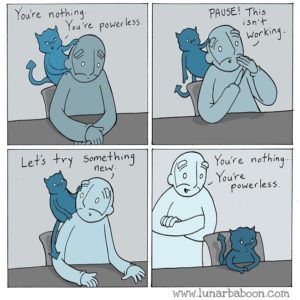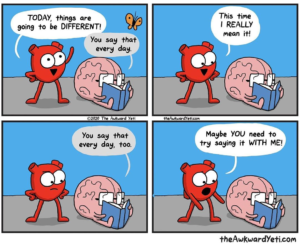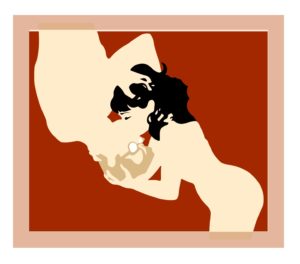A Short Taxonomy of Denial and Mulishness
“You can beat 40 scholars with one fact, but you can’t beat one idiot with 40 facts.” –Mevlana
Watching a fly repeatedly bonk into a window to get outside we shake our heads. That fly seems like the dumbest thing on earth, but if we encountered an invisible force field preventing us from leaving the house through an open door, I bet we’d spend half an hour throwing ourselves at it. The moment we figured out a practical solution we’d drop the failed approach and never look back. Of course, right?
In many aspects of life, the answer is no. The average human being probably has more than one life issue where they reject solutions and embrace failure. We may be more loyal to our failures than our stated goals.
This behavior is known as Escalation of Commitment and the mindset enabling it is called: The Sunk Cost Fallacy.
<Wikipedia>
Escalation of commitment is a human behavior pattern in which an individual or group facing increasingly negative outcomes from a decision, action, or investment nevertheless continues the behavior instead of altering course. The actor maintains behaviors that are irrational, but align with previous decisions and actions.
Economists and behavioral scientists use a related term, Sunk-Cost Fallacy (aka commitment bias), to describe the justification of increased investment of money, time, lives, etc. in a decision, based on the cumulative prior investment (“sunk cost”) despite new evidence suggesting that the cost, beginning immediately, of continuing the decision outweighs the expected benefit.
</Wikipedia>
The classic example is people who go bust on a stock purchase by tenaciously riding it down one devaluation after another until it craters. From the outside, it looks like they drove off a cliff despite having every opportunity to …not drive off a cliff! In any investment, there are more things at stake than the obvious ones. Internally, they made a series of decisions shaped by loyalty, denial, magical thinking, social embarrassment, AND their earlier decisions.
Here are two likely areas to make you hunker in the bunker and here is what that sounds like:
Marriage:
- We just need to get past this rough patch.
- It just seems exhausting to start over and we’ve been through so much together.
- He says he wants to change.
- I couldn’t bear that “I told you so” look from friends and family. Even having to hear all the sincere sympathy would crush me.
- Nobody is super happy all the time, don’t be such a princess.
- The kids would be so disappointed, what sort of an example would I be setting?
- I can’t even think about that with so much going on.
The Job:
- Only 9 more years.
- I’m lucky to have this in the current economy. I’d be an idiot to jump ship now.
- I have no idea what I’d do instead.
- It’s not so bad, I kind of feel at home here.
- My family would think I was crazy. Everyone is counting on me holding it together.
- Who would I even be if I wasn’t this?
Most of us are caught somewhere between compromise and refusing to compromise, a place that isn’t quite either: living in half-assed misery and so-so happiness. I’m not suggesting everyone should cash in their chips on commitments and choices. I’m just audio micing some of the most common voices in the head as we mull things over. Many of the voices aren’t even this obvious, they surface as sighs and twinges of regret that we dutifully ignore.
Of course in culture and politics, we begin to encounter philosophical and team-based intransigence.
- Belief perseverance is when the belief hardens and becomes MORE resistant when it encounters new and contradictory or debunking information. When you go to a climate change denier with scientific facts they come away less confident about Science.
- Cognitive inertia is the persistence of our style of resisting new information, our attitudes, and approaches to examining our beliefs. We may feel a lack of motivation to take things seriously or display a condescending impatience toward other opinions for example.
- True believer syndrome refers to clinging to thoroughly debunked or disproven beliefs. This is a good place to mention Apophenia which overlaps a bit. Either google it or take a look at my article “Apophenia: The liar inside” it’s basically being swallowed whole by an idea.
- The Asch Conformity Experiments were a series of studies directed by Solomon Asch studying if and how individuals yielded to or defied a majority group and the effect of such influences on beliefs and opinions. We are more deeply wired into the reactions of those around us than we know. If you cave in to outside pressure it’s generally something that doesn’t feel volitional. It’s more like something you observe yourself automatically doing than something you choose to do after reflection. This the painful filter that conscience or bravery must battle through to take an unpopular stand.
“Insanity Is Doing the Same Thing Over and Over Again and Expecting Different Results” – Not Albert Einstein as it turns out
When you consider all this auto-pilot cussedness you have to wonder what the hell is wrong with us. Don’t we sound just awful? When beliefs are threats to the safety and autonomy of a community they are clearly toxic. The beliefs of Nazis or the Khmer Rouge are cultural poison gas and the most common sense response is hitting them with a frying pan till they stop moving.
But day to day human inertia and resistance, even when it’s infuriatingly dumb, is a feature, not a bug. From nature’s point of view, we are a hive species that operates through massed individual actions but above the pay grade of those individuals to interpret. Your prickly intransigence in certain areas is pretty much your marching orders from human central. Whether you are conservative, progressive, religious, atheist, narcissist, or concerned citizen you are a die-cast component of a bottom-up, beyond-control species life script.
A very clear, 5 minute “explain it like I was 13” introduction to Epigenetics. This is the most important new topic in the science of evolution. The implications are much deeper and broader than suggested here.
If you’d like to hear more about these implications, click this link to the Epigenetics category. This will be the first post, with the others just below.
The Arbitrary Self
Depressive behavior such as bad sleep hygiene, inactivity, social avoidance, over-thinking, etc. Evokes in us a loser personality: The feeling of being a loser. The deeper that feeling, and the more we buy into it, the more we come to see it as a fact. Since only a fool argues with facts, we limit our hopes, minimize risks, and adapt to the dispiriting expectations. Down we go.
Better self-care like exercising, meditating, cleaning up, etc, begins to evoke a can-do sort of personality, who feels at least more like a winner. Again, the more we believe that winner feeling the more factual it seems. This person starts more conversations and makes more ambitious plans for themselves.
Of course, we have core phenotypic personalities from birth but they morph into variations on your theme based on what we “feed” them. Obviously, our actions are catalysts for good or bad outcomes, but the power steering the life that follows is our identification with upbeat or hopeless feelings. The resulting sense of self from either path becomes the self-fulfilling prophecy of a life lived according to the optimism or pessimism flavoring each moment.
So self-talk shapes the future, but self-talk also shapes our beliefs about taking better actions to feel better. There is already a sense of reality, of fact, firmly in place and talking to us about whether there’s any point in trying.
Think of your disappointments. Perhaps you can’t get into shape, can’t find the right person or the right job. If you are already rejecting what I seem to be suggesting, I’d like you to notice the mechanical negative voice in you directing the course of your future life. This voice demonstrably has an executive role in your decisions…which suggests it is the project manager for you getting into shape, finding love, and finding a job. To get anywhere with this you need to understand your relationship to that voice. Who is it? Who put it in charge? Why does it remain in charge despite poor results?
First of all, it isn’t really you, and it isn’t alive…its a mechanism. Next, it doesn’t automatically have your best interests at heart, it’s like the cumulative rejections, real and imagined, absorbed by you as a child. These have compressed into this thing carried inside you like a piece of shrapnel. It isn’t even you, save that you have internalized it. It is the voices of those who made you feel hopeless, alone, and unwanted on loop. Eventually, it sounds so familiar you think it’s your own voice. When something silences the voice you feel strange and exposed, naked in the open. You may feel ashamed and foolish to think positive thoughts about yourself and your future. We don’t recognize ourselves without it yet it is literally the voice of our enemies, crystalized in us as grief and shame. Grief and shame become filters for our hopes.
Some of us are born more vulnerable to criticism and judgment, and some nearly immune. But who we seem to be today is the rather arbitrary result of the coping mechanisms, self-talk, and self-care that took shape in us in the overheated darkness of very early childhood. None of it was inevitable or fated. To deal with the world, we tried things, some worked and we clung to those and built upon their theme. Our style of communication and problem solving, listening, etc. is the result of hundreds of battle strategies formed in struggles with parents, siblings, strangers and ourselves.
We are most oppressed and limited by certain ideas we have complete faith in. That faith may be so strong that we don’t even know it is there because we trust it as we trust our next breath of air. It’s this arbitrariness about who we think we are that must be deconstructed if we want more freedom and choice. Your problems with weight and love and work are created and managed by the same perspective you send in to solve them. That mind doesn’t understand how it creates these problems or why it fails to solve them. Most of the changes we long to see in ourselves depend upon steps that our executive decider automatically rejects out of hand. Our first problem isn’t our weight, love, or work. It is the self we wholeheartedly believe we are.
Two Simple, Useful Techniques
- Meditation of any flavor loosens the ropes and offers many other benefits. But doing positive self-talk meditation makes two things happen, A. You actually start to feel more positive, and B. The negative voices are still there like Goth Mynah birds but by changing the general tone of self-talk for the better you will actually hear the negative voices as distinct, and not really your voice. Then you can look at their simple mechanism and bit by bit shut it down and replace it. This is a conscious process over the long run with gradual improvements. If you feel a lot of resistance at the start of positive self-talk it’s certain that you should try this.
- Go online and take an Enneagram test. These aren’t like Myers-Briggs or Astrology. The enneagram is basically a portrait of arbitrary self, what Gurdjieff called “false personality”. Don’t get hooked on whether the traits are good or not, as people work on themselves they gradually become less clearly any one of the types because their goofy coping strategies aren’t leading them around behaving mechanically.
from Michael Donaghy’s Collected Poems
For the present there is just one moon,
though every level pond gives back another.
But the bright disc shining in the black lagoon,
perceived by astrophysicist and lover,
is milliseconds old. And even that light’s
seven minutes older than its source.
And the stars we think we see on moonless nights
are long extinguished. And, of course,
this very moment, as you read this line,
is literally gone before you know it.
Forget the here-and-now. We have no time
but this device of wantonness and wit.
Make me this present then: your hand in mine,
and we’ll live out our lives in it.
Today is the first day of Fall.
My 3-year-old son and I went to the beach and ate hamburgers in the car.
Then crossed the railroad bridge to the saw grass and sand.
The air balanced gently between warm and cold. In the sunshine, the last of summer’s heat warms our skin like a loving farewell.
We dug soft sand and threw rocks and wandered as you only wander with a child.
Nothing to accomplish. No hurry.
A stream comes out of the forest, clear and cold as when it melted into a torrent a hundred miles away, up a mountain from here. Red and yellow leaves ride the stream to its end where sweet water joins salt. Salmon fingerlings pass through to the sea.
We lie on the sand watching dark blue waves and the patchwork sky of scudding clouds like massive billowed sails.
Hundreds of migrating crows come to drink from the stream and caper between sky and ground like flowing ink, written too fast to read.
They tease and flirt like teenagers in the park.
We play with toy cars, dwarfed beside the grey bones of a giant tree that drank sun for hundreds of years before it fell and drifted here; and Isaac repeats the question we all ask, waking to this world:
Why
Why
Why
Why
Why?
Song by Jonathon Coulton, Typography animation by Andrewthevideo
There is a longer version of this wonderful song, very worth a listen, it just doesn’t come with this great animation.
Everybody sing along!



